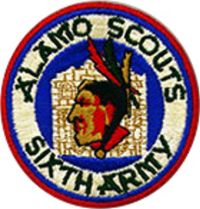
The United States Army Rangers are U.S. Army personnel who have served in any unit which has held the official designation of "Ranger". The term is commonly used to include graduates of the Ranger School, even if they have never served in a "Ranger" unit; the vast majority of Ranger school graduates never serve in Ranger units and are considered "Ranger qualified".

A long-range reconnaissance patrol, or LRRP, is a small, well-armed reconnaissance team that patrols deep in enemy-held territory.
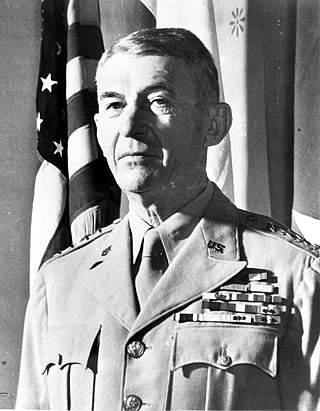
Walter Krueger was an American soldier and general officer in the first half of the 20th century. He commanded the Sixth United States Army in the South West Pacific Area during World War II. He rose from the rank of private to general in the United States Army.

Ghost Soldiers: The Epic Account of World War II's Greatest Rescue Mission is a non-fiction book written by Hampton Sides. It is about the World War II Allied prison camp raid at Cabanatuan in the Philippines.

Henry Andrews Mucci was a colonel in the United States Army Rangers. In January 1945, during World War II, he led a force of 121 Army Rangers on a mission which rescued 513 survivors of the Bataan Death March from Cabanatuan Prison Camp, despite being heavily outnumbered. It is widely considered the most successful rescue mission in the history of the United States military.
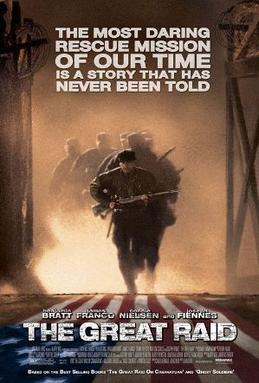
The Great Raid is a 2005 war film about the Raid at Cabanatuan on the island of Luzon, Philippines during World War II. It is directed by John Dahl and stars Benjamin Bratt, James Franco, Connie Nielsen, Marton Csokas, Joseph Fiennes with Motoki Kobayashi and Cesar Montano. The principal photography took place from July 4 to November 6, 2002, but its release was delayed several times from the original target of fall 2003. The film received negative to average reviews from critics and was a commercial failure.
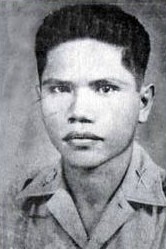
Captain Juan Pajota was involved in the Raid at Cabanatuan, an action which took place in the Philippines on 30 January 1945 by US Army Rangers and Filipino guerrillas and resulted in the liberation of more than 511 American prisoners of war (POWs) from a Japanese POW camp near Cabanatuan.

The 6th Ranger Battalion was a United States Army Ranger Battalion which saw action in the Pacific during World War II. The battalion is best known for its role in the Raid at Cabanatuan in the Philippines in January 1945.

The Raid on Los Baños in the Philippines, early Friday morning on 23 February 1945, was executed by a combined United States Army Airborne and Filipino guerrilla task force, resulting in the liberation of 2,147 Allied civilian and military internees from an agricultural school campus turned Japanese internment camp. The 250 Japanese in the garrison were killed. It has been celebrated as one of the most successful rescue operations in modern military history. It was the second precisely-executed raid by combined U.S.-Filipino forces within a month, following on the heels of the Raid at Cabanatuan at Luzon on 30 January, in which 522 Allied military POWs had been rescued. The air/sea/land raid was the subject of a 2015 nonfiction book, Rescue at Los Baños: The Most Daring Prison Camp Raid of World War II, by New York Times bestselling author Bruce Henderson.

Robert Lapham was a reserve lieutenant in the US Army in World War II. He served in the Philippines attached to the 45th Infantry, evaded capture in the spring of 1942, and organized and led one of the largest and most successful guerrilla armies on the central plains of the northern island of Luzon. He was promoted to major by war's end, age 28, and was awarded the Distinguished Service Cross by General Douglas MacArthur. Lapham was the third person, after President Franklin Delano Roosevelt and MacArthur, to receive the Philippine Legion of Honor. Historian Norling says that Laphams's Luzon Guerrilla Army Force (LGAF) was probably the most efficient of the many guerrilla armies on Luzon. The U.S. Guerrilla Affairs Division commended Lapham for having the best-disciplined guerrilla organization.
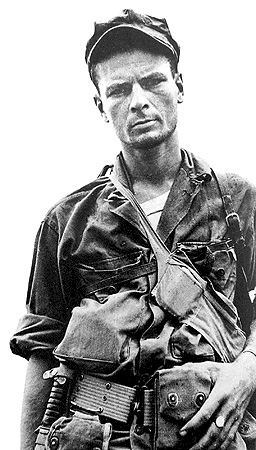
Robert W. Prince was an officer in the United States Army's elite 6th Ranger Battalion. In 1945 he was chosen personally by Lt. Col. Henry Mucci to plan the rescue at the Cabanatuan POW camp in the Philippines.

Back to Bataan is a 1945 American black-and-white World War II war film drama from RKO Radio Pictures, produced by Robert Fellows, directed by Edward Dmytryk, that stars John Wayne and Anthony Quinn. The film depicts events that took place after the Battle of Bataan (1941–42) on the island of Luzon in the Philippines. The working title of the film was The Invisible Army.
A long-range penetration patrol, group, or force is a special operations unit capable of operating long distances behind enemy lines far away from direct contact with friendly forces as opposed to a Long Range Reconnaissance Patrol, a small group primarily engaged in scouting missions.
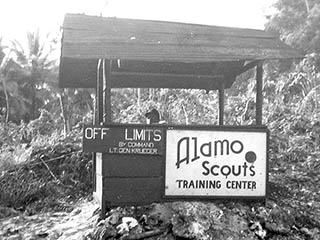
Training camp and headquarters of the U.S. Sixth Army Special Reconnaissance Unit, known as the Alamo Scouts. They served in the Southwest Pacific Theater during World War II.

Special forces or special operations forces (SOF) are military units trained to conduct special operations. NATO has defined special operations as "military activities conducted by specially designated, organized, selected, trained and equipped forces using unconventional techniques and modes of employment".

Rafael Manio Ileto was a Filipino general who served as the 22nd Secretary of the Department of National Defense (DND) of the Philippines. He also became the Vice Chief of Staff of the Armed Forces of the Philippines (AFP). He also served as Philippine Ambassador to Turkey, Iran, Cambodia, Thailand, and Laos.

During the Japanese occupation of the islands in World War II, there was an extensive Philippine resistance movement, which opposed the Japanese and their collaborators with active underground and guerrilla activity that increased over the years. Fighting the guerrillas – apart from the Japanese regular forces – were a Japanese-formed Bureau of Constabulary, the Kenpeitai, and the Makapili. Postwar studies estimate that around 260,000 people were organized under guerrilla groups and that members of anti-Japanese underground organizations were more numerous. Such was their effectiveness that by the end of World War II, Japan controlled only twelve of the forty-eight provinces.

The Cabanatuan American Memorial is a World War II memorial located in Cabanatuan, Nueva Ecija in the Philippines. It is located on the site of what was once Camp Pangatian, a military training camp which operated for twenty years until it was converted into an internment camp for Allied prisoners of war during the Japanese occupation.
Bataan Rescue is a 2003 television documentary film about the Raid at Cabanatuan. Produced by PBS for the American Experience documentary program, it begins with the Fall of Bataan in 1942 up to the titular event in January 1945, where more than 500 prisoners of war were liberated from a Japanese camp in Cabanatuan, Nueva Ecija. Directed by Peter Jones and written and produced by David Axelrod, the film first aired on PBS in the United States on July 7, 2003.
